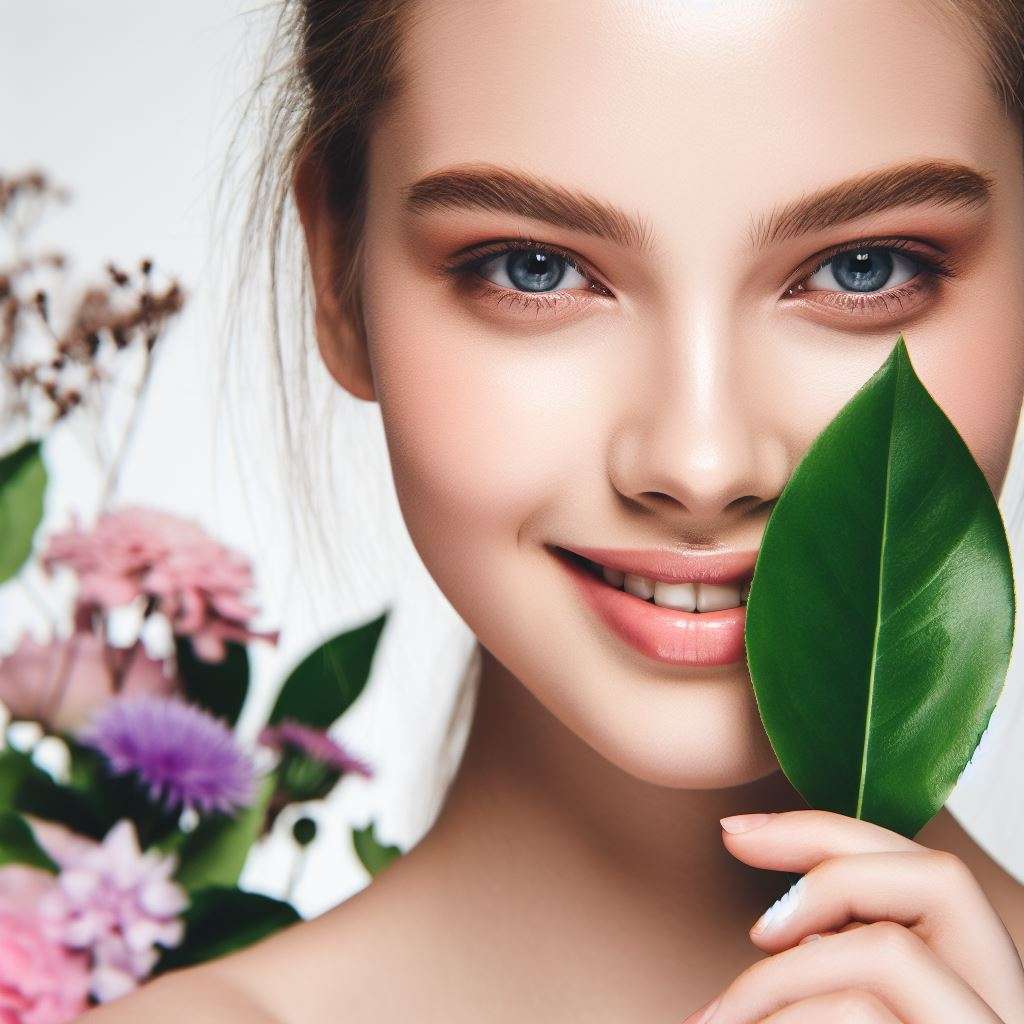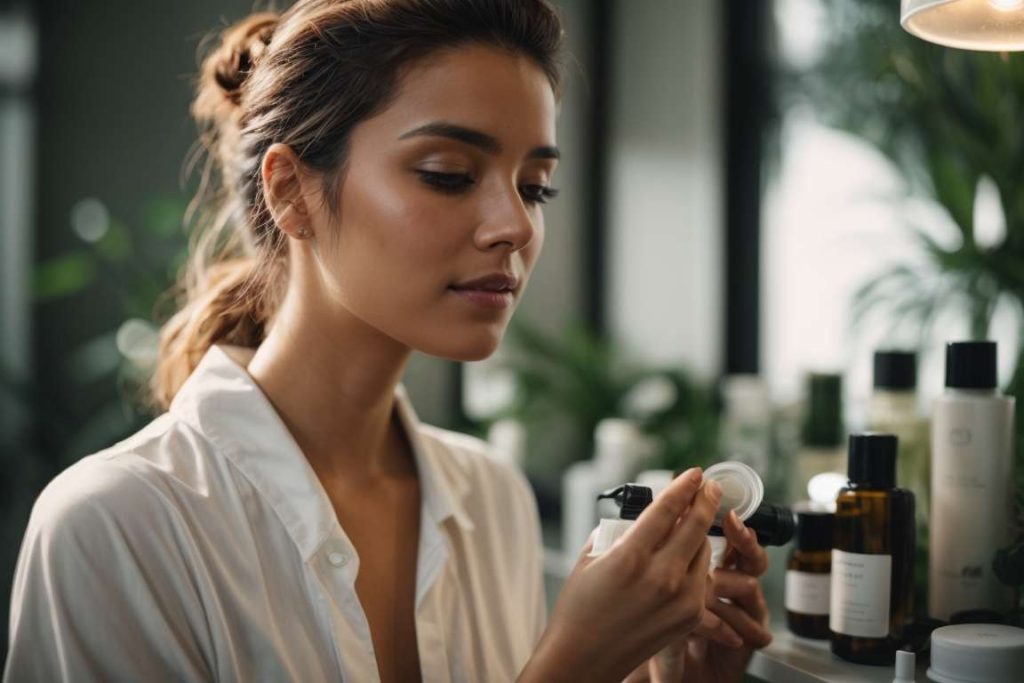What Is Your Skin Type?
There are five main skin types:
- Normal
- Dry
- Oily
- Combination
- Sensitive

While genetics play a role, your skin type can also change over time due to hormonal fluctuations, medications, health conditions, and environmental factors like weather and pollution (1). Knowing your baseline skin type helps you recognize when you may need to adjust your routine.
For example, normal skin has an even texture, small pores, and few imperfections. It’s neither excessively oily nor dry. Dry skin lacks oil and feels tight or flaky, especially after cleansing. Oily skin looks shiny and can have large, visible pores. Combination skin exhibits dry patches and oiliness in different areas. Sensitive skin easily becomes red, irritated, or inflamed (2).
If you’re unsure of your skin type, pay attention to how your skin looks and feels throughout the day. Note if your skin becomes more oily or dry at certain times. Tracking lifestyle factors like your menstrual cycle, stress levels, sleep, and diet can also provide clues about what’s causing changes in your skin (3).
Custom Skincare Planner
Discover your customized skincare routine! Just select your skin type, age group, and skin concerns below to receive expert product recommendations for morning and evening. This comprehensive guide provides tailored skincare advice for women of all ages and skin types. Find the perfect routine just for you!
Disclaimer: This skincare recommendation tool provides general guidance based on common product suggestions for different skin types, ages, and concerns. It should not be used as a substitute for professional medical advice. Always consult your dermatologist before trying new products, especially if you have sensitive skin or conditions like acne, rosacea, or eczema. Discontinue use if irritation occurs. The content is for informational purposes only and should not be considered skincare prescriptions or directives.
Comprehensive Skincare Guide for Women
We hope this tool has helped you discover the ideal personalized skincare routine for your unique needs! Remember that consistency is key – be diligent in following both the morning and evening regimen for your skin type and concerns. Don’t forget to also drink plenty of water, protect your skin from sun exposure, and make healthy lifestyle choices for overall skin health and beauty. Please consult your dermatologist if you have any concerns or need help getting started on your new skincare journey.
How Does Skin Age?
There are two main ways our skin ages:
Intrinsic aging
This natural process occurs as we get older. Collagen and elastin production slows down, leading to fine lines, wrinkles, and loss of elasticity. Skin also becomes thinner and more fragile. The lipid barrier weakens, increasing transepidermal water loss (TEWL). This makes skin drier (4).
“Ageing is inevitable, but looking your age is optional.” – Carolyn Heilbrun
Extrinsic aging
Environmental factors like UV exposure from the sun and pollution produce free radicals that damage skin proteins, lipids, and DNA. This oxidative stress accelerates the appearance of fine lines, wrinkles, and hyperpigmentation. Lifestyle factors like smoking also contribute. The degree of extrinsic skin aging depends on your exposure and protection levels (5).
By understanding the mechanisms behind intrinsic and extrinsic aging, you can create a targeted anti-aging routine with ingredients like retinoids, antioxidants, and sunscreen. Preventative skincare can help minimize premature aging (6).
The Importance of pH
The pH scale measures how acidic or alkaline/basic a substance is. Human skin maintains an average pH of 4.7, which is slightly acidic. This acid mantle is integral to skin health and protects against bacteria, pollution, and moisture loss. Many cleansers and soaps are alkaline with pH levels around 8-9. This disrupts the acid mantle, compromising the skin barrier (7).
Look for cleansers with a pH closer to your skin’s natural pH. You can also use a toner with alpha hydroxy acids like glycolic acid or lactic acid to help rebalance your skin’s pH after cleansing. Excess alkalinity causes inflammation, dryness, acne, and sensitivity. Restoring your acid mantle inhibits these issues and allows other skincare products to better penetrate (8).
How Retinoids Work
Retinoids or vitamin A derivatives are some of the most clinically proven anti-ageing ingredients. They regulate cellular turnover and stimulate collagen production to minimize fine lines and wrinkles. Retinoids also unclog pores and exfoliate to reduce acne (9).
There are three generations of retinoids:
- First generation: Retinol – Less irritating than prescription retinoids, retinol must be converted to retinoic acid to work. Results take longer.
- Second generation: Retinaldehyde – More potent than retinol without a prescription. Faster results with less irritation.
- Third generation: Adapalene and tretinoin – Prescription retinoids rapidly exfoliate the skin to reduce lines and acne. Higher irritation (10).
Start with an over-the-counter retinol or retinaldehyde and slowly build up your tolerance. Use retinoids at night and follow with moisturizer to reduce dryness and peeling. Sun protection is critical, as retinoids make skin more sun-sensitive (11).
Alpha Hydroxy Acids (AHAs)
AHAs like glycolic, lactic, citric, and mandelic acids are water-soluble chemical exfoliants derived from fruits and sugars. At a low pH of 3-4, AHAs help detach dead skin cells and stimulate cell turnover to reveal brighter, smoother skin (12).
They also enhance collagen production, increase hyaluronic acid levels for hydration, and reduce hyperpigmentation. Benefits include:
- Refining skin texture
- Unclogging pores
- Reducing fine lines and wrinkles
- Improving skin tone and radiance
- Minimizing dark spots
Start with weekly application and slowly increase frequency based on your tolerance. Irritation and sun sensitivity can occur. Follow with SPF in the mornings (13).
“AHAs are like microdermabrasion in a bottle.” – Dr. Shereene Idriss

Different Types of Chemical Exfoliants
In addition to AHAs, chemical exfoliants like beta hydroxy acids (BHAs) and poly hydroxy acids (PHAs) also slough off dead skin cells. This guide covers the main categories:
AHAs
- Glycolic acid: smallest AHA molecule, penetrates best to work on surface and deeper layers
- Lactic acid: hydrating, improves skin elasticity and firmness
- Mandelic acid: antibacterial, suitable for sensitive skin
- Citric acid: brightening, extracted from citrus fruits
BHAs
- Salicylic acid: oil-soluble, penetrates pores to reduce acne
- Betaine salicylate: gentler alternative to salicylic
PHAs
- Gluconolactone: hydrating, and strengthens the skin barrier
- Lactobionic acid: antioxidant and hydrating properties
Start slowly with a once or twice-weekly application. Only use one active chemical exfoliant in your routine and follow with SPF (14).
Humectants for Hydration
Humectants are hygroscopic substances that attract and bind moisture to the skin. This hydrates surface layers and reduces transepidermal water loss (TEWL) to improve skin smoothness, suppleness, and glow (15).
Glycerin and hyaluronic acid are common humectant ingredients. They pull moisture from the dermis to the epidermis and from the environment into skin (16).
Look for serums, essences, and moisturizers with humectants like:
- Glycerin: hydrating polyol compound
- Hyaluronic acid: binds and retains 1000x its weight in water
- Sorbitol: alditol with water-binding properties
- Propylene glycol: humectant and penetration enhancer
- Sodium PCA: derived from amino acids, attracts and retains moisture
Humectants work best layered under an occlusive like petroleum jelly or mineral oil. Occlusives seal in moisture and prevent evaporation for amplified hydration (17).

Niacinamide Benefits
Also known as vitamin B3, niacinamide is a potent skin-restoring ingredient. It has many benefits:
- Repairs skin barrier
- Reduces transepidermal water loss
- Increases collagen production
- Evens skin tone and fades dark spots
- Minimizes pores
- Decreases fine lines and wrinkles
- Reduces inflammation and blotchiness
- Improves skin elasticity (18)
Niacinamide is gentle and effective for all skin types. It has an optimal concentration range of 2-5%. When using other actives like vitamin C or retinoids, separate the application to avoid irritation. The amide form causes less flushing than niacin (19).
“Niacinamide is a multitasking powerhouse for all skin types.” – Dr. Shasa Hu
Antioxidants for Protection
Antioxidants neutralize free radicals from UV exposure, pollution, smoke, stress, and other environmental factors that damage skin. Topical application adds protection against oxidative stress to maintain healthy skin (20).
Some of the most researched antioxidant ingredients include:
- Vitamin C: Boosts collagen, brightens skin, reduces fine lines and wrinkles
- Vitamin E: Nutrient-rich oil to moisturize and protect skin barrier
- Resveratrol: Plant compound with anti-inflammatory effects
- Coenzyme Q10 (CoQ10): Energy-boosting enzyme that protects mitochondria
- Ferulic acid: Plant chemical that stabilizes vitamins C+E
- Astaxanthin: Red pigment from marine algae to reduce hyperpigmentation
- Polyphenols: Antioxidant plant compounds like from green tea (21)
Use antioxidant serums in the mornings before sunscreen. Combining antioxidants like vitamins C and E can increase photoprotection (22).
Understanding Prebiotics and Probiotics
Friendly bacteria on the skin play a protective role. Prebiotics feed good bacteria, while probiotics are live microorganisms that provide benefits when applied topically.
Prebiotics:
- Fibers that feed probiotics and enhance the microbiome
- Support skin barrier function and immunity
- Reduce inflammation and sensitivity (23)
Probiotics:
- Strains like Lactobacillus may inhibit pathogens
- Reduce acne and dermatitis when applied topically
- Require actual live cultures, not just ferments (24)
Look for prebiotic ingredients like pomegranate and probiotic strains like Lactobacillus ferment on product labels. Pair them with gentle cleansers to avoid disrupting the skin microbiome (25).

Ceramides Keep Skin Smooth
Ceramides are waxy lipid molecules that makeup 50% of skin’s composition and help form the protective barrier. Depletion of ceramides leads to transepidermal water loss, irritation, and aged appearance (26).
Topical application in moisturizers, serums, and oils helps:
- Strengthen skin barrier
- Increase hydration and elasticity
- Smooth skin texture
- Calm eczema and dermatitis
- Reduce irritation from retinoids (27)
The three main ceramide types:
- Ceramide 1: Protects against irritants
- Ceramide 3: Benefits eczema-prone skin
- Ceramide 6: Hydrating fatty acid (28)
Look for products containing ceramide NP to replenish skin and reinforce its moisture barrier (29).
What Causes Breakouts?
Acne forms when dead skin cells, oil, and bacteria clog pores. Hormonal fluctuations, medications, diet, and stress can trigger excess oil production and inflammation. Breakouts commonly occur on the face, back, chest, and shoulders (30).
Main causes include:
- Excess sebum production
- Follicular hyperkeratinization – dead skin buildup
- Colonization of Cutibacterium acnes bacteria
- Inflammation and irritation (31)
Acne-fighting ingredients target different parts of the process. For example:
- Retinoids exfoliate and unclog pores
- Benzoyl peroxide kills acne bacteria
- Tea tree oil reduces inflammation
- Niacinamide minimizes sebum production
Try combinations like retinol with benzoyl peroxide or salicylic acid with niacinamide. Avoid excessive drying and irritation. See a dermatologist for prescription medications if over-the-counter options are ineffective (32).
How Pigmentation Develops
Hyperpigmentation in the form of dark spots, melasma, and sun spots occurs when melanin overproduces in certain areas. This is caused by:
- UV exposure
- Inflammation from acne or eczema
- Hormonal changes
- Genetic factors (33)
Ingredients that interfere with melanin synthesis lighten pigmentation. For example:
- Hydroquinone: Blocks tyrosinase enzyme pathway
- Vitamin C: Inhibits tyrosinase to brighten skin
- Tranexamic acid: Amino acid derivative to treat melasma
- Kojic acid: Fungus-derived acid prevents melanin formation
- Arbutin: Bearberry plant extract suppresses melanin (34)
Always pair with SPF to prevent further sun damage. Hydroquinone and other potentially irritating lighteners require supervision from a dermatologist (35).
Conclusion
Skincare technology has expanded rapidly, but the basics remain the same. Know your skin type, protect it from the elements, feed it with nourishing ingredients, and address specific concerns as needed. Learning about how active ingredients work on a cellular level helps you make customized choices for your routine.
Remember to introduce new products slowly and pay attention to how your skin reacts. Seeing a dermatologist for stubborn skin issues can optimize your results. With consistent prevention and care tailored to your skin’s needs, you can achieve healthy, glowing skin at any age.
References
- Environmental Factors Affecting Skin Type – Environmental Factors That Affect Your Skin
- Characteristics of sensitive skin – Sensitive Skin: Overview
- Lifestyle Factors Influencing Skin Changes – How Lifestyle Impacts Your Skin
- Intrinsic aging and its effects on skin – Intrinsic and extrinsic factors in skin ageing: a review
- Extrinsic aging and its impact on skin health – Extrinsic Aging: A Synergistic and Evolving Science
- Preventative skincare for premature ageing – Prevention of Premature Aging
- The role of pH in skin health – The importance and role of pH in human skin
- Effects of alkalinity on skin – Alkaline Skin Washes Can Heighten Irritability and Dryness
- Benefits of retinoids in skincare – Retinoids in the treatment of skin aging
- Three generations of retinoids – Retinoids: active molecules influencing skin structure formation in cosmetic and dermatological treatments
- Retinoids and sun sensitivity – Retinoids and the skin
- Alpha Hydroxy Acids and their Benefits – Alpha Hydroxy Acids for Skin Care
- AHAs and sun protection – The use of alpha hydroxy acids in skin care products
- Different types of chemical exfoliants – Chemical Exfoliation
- Humectants and their role in hydration – Humectants in dermatology
- Glycerin and hyaluronic acid as humectants – Glycerin: a key ingredient for skin care
- Using occlusives with humectants – Moisturizers: The Slippery Road
- Benefits of niacinamide in skincare – Niacinamide: A B vitamin that improves aging facial skin appearance
- Using niacinamide with other actives – The role of niacinamide in skin health
- Antioxidants and their protective role – Antioxidants and the skin
- Research on antioxidant ingredients – Antioxidants used in skin care formulations
- Combining antioxidants for photoprotection – Antioxidants and photoprotection in a broad-spectrum sunscreen
- Understanding prebiotics in skincare – The role of prebiotics and probiotics in skin health
- Role of probiotics in skin health – Probiotics for the skin
- Prebiotics and probiotics in product labels – The skin microbiome: impact of modern environments on skin ecology, barrier integrity, and systemic immune programming
- Ceramides and their importance in skin – The role of ceramides in skin health
- Benefits of topical ceramide application – Ceramides and skin function
- Three main types of ceramides – Ceramides and epidermal function
- Products containing ceramide NP – Ceramide NP: A Review of its Use in the Management of Skin Disorders
- Causes of acne breakouts – Causes and Treatment of Acne
- Main causes of acne – The pathogenesis of acne
- Acne-fighting ingredients and their roles – Acne: Treatment and Drugs
- Causes of hyperpigmentation – Hyperpigmentation: types, diagnostics and targeted treatment options
- Ingredients for treating pigmentation – Cosmeceuticals for Hyperpigmentation: What is Available?
- Using SPF with pigmentation treatments – The Role of Sunscreen in Melasma and Postinflammatory Hyperpigmentation

Dive deep into the world of Neha Z., a passionate writer and seasoned blogger. For over half a decade, she’s been sharing her life’s stories and experiences. Neha’s expertise isn’t just limited to her personal tales; she delves into everything women-centric. From life’s ups and downs to the nuances of womanhood, if it’s about women, Neha writes it with flair and authenticity. Join her journey and be inspired by her words!
Reviewed By: Joanna Perez and Edited By: Lenny Terra
Fact Checked By: Brenda Tillman
Photos Taken or Curated By: Matthew Mansour